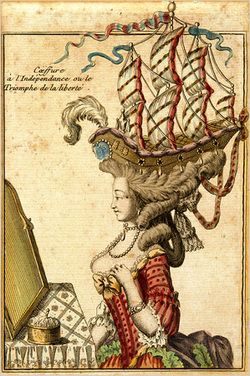 by Xin Wen At the age of 14, Marie Antoinette was sent by her mother- Maria Theresa of Austria to France to be the wife of the future king- Louis XVI. On her way to the foreign country, just after she set foot on the soil of Bourbon, she was asked to get rid of all the Austrian things she was carrying. Even her little puppy was taken from her. (As shown in the movie Marie Antoinette, directed by Sophia Coppola). In front of many noble people’s staring, she was stripped bare and given a whole set of French clothes. The little young princess burst into tears. 241 years later, we don’t know whether this awkward experience ruined the first impression of French people for Marie Antoinette, what we do know is that French people in 18th century pretty much hated her. Why? Because in Zweig’s words: ‘From the outset, the Queen’s mistake was that she wished to conquer as woman instead of as queen.’ During her 15 years of Queen she cast her primary energy on clothes, hairstyle, party, and gamble. She had great interests in everything except for the affairs of state. A typical day of Marie Antoinette starts at 11pm, ends at 5am approximately. As soon as she got up, she had to decide which gown to wear (which could take a few hours), and after that she let her hair done by her beloved hairdresser- Monsieur Leonard.  The hairstyle this gentlemen offered was exaggerated, pretty fit into the zeitgeist of 18th century—Rococo art. Here is how the hair was done: ‘To begin with, by means of huge hairpins and a lavish expenditure of stiff pomade, the hair was strained upwards from the temples like a huge flaming candle, about twice the height of the pointed head-dress of a Prussian grenadier.’ (Stefan Zweig, <Marie Antoinette—the portrait of an average woman>) When Marie Antoinette’s mother in Vienna heard about the 36-inch-height of hair her daughter was carrying, she was furious and wrote letters to warn the Queen of France. However, Marie Antoinette did not take any cordial advice. Soon the hairstyle was popular among the circle around Palais de Versailles. Since the hair of noblewomen was too high, the ceilings of boxes were changed into vaults. Sometimes women could not sit in the carriages-- for the safety of their hair, they had to kneel down. However, height was not the only object; political sensitivity was also valued: the hairstyle even reflected current events. ‘In the free space, eighteen inches above the eyebrows, began the artist’s plastic realm. Not only were landscapes and panoramas, with fruit, gardens, houses, ships, the sea in a storm, the whole motley world, but, to provide for sufficiently frequent changes in fashion, the event of the day had to be symbolized in this superstructure.’ (Stefan Zweig, <Marie Antoinette—the portrait of an average woman>) Though hard to believe nowadays, Marie Antoinette actually got a boat on her head: ‘When France joined forces with the American revolutionaries, Marie Antoinette showed her support by wearing an intricate hairdo displaying a French frigate that won a key victory against the British in June 1778.’ (Caroline Weber, <Queen of Fashion>) Marie Antoinette was a classic representative of 18th century. She totally embraced the zeitgeist, and even elaborated and extended it at the cost of her life. Over the years, she squandered money on nothing related to the governing of the country. (She was not that into shoes as the 2006 movie showed). Her poor husband never blamed her; instead he paid her debts and tried his best to let Marie be the only peacock in the court.
However, French people did not have the same tolerance as Louis Louis XVI: sarcastic cartoons and rumors pervade; people attributed the empty national treasury to the life style of Marie Antoinette. Meanwhile she retained her extravagance without being slightly aware of the upcoming danger. That’s when the seed of her future death was planted. That’s when the tragedy of the Queen of Rococo started. Reference: Stefan Zweig, <Marie Antoinette>, Pushkin Press, 2010 Caroline Weber, <Queen of Fashion>, Henry Holt and Company, 2006 Anne Hollander, <The Queen's closet—What Marie Antoinette really wore>, Slate Liesl Schillinger, <The Queen's Wardrobe>,NY times The first picture comes from the website of Palais de Versailles The second picture comes from http://www.cfa.ilstu.edu/lmlowel/ The last one comes from <The Queen's wardrobe>, by Liesl Schillinger |
Archives
June 2017
Categories
All
|

 RSS Feed
RSS Feed